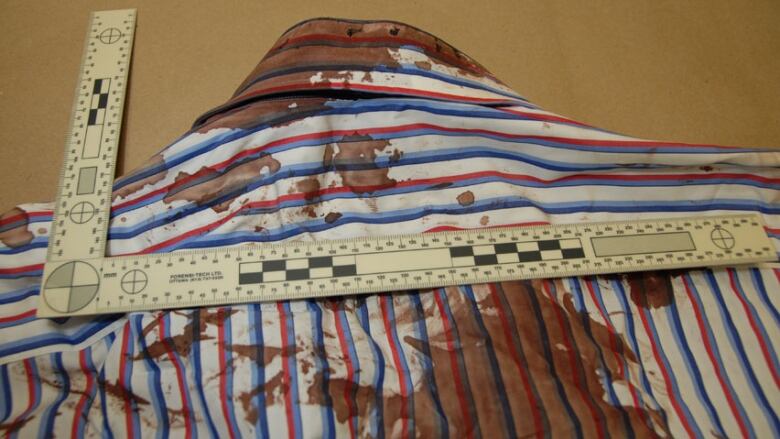Dennis Oland murder retrial hears more details about bloodstained jacket
Oland's 2nd-degree murder retrial in father's 2011 death hears from bloodstain-pattern analyst
Dennis Oland's murder retrial heard more details Thursday about a key piece of evidence in the Crown's case against him: thebrown sports jacket he was wearing when he visited his father on the night he was killed.
RCMPSgt. BrianWentzell,a bloodstain pattern analyst, testified about several stains found on various areas of the jacket. Theseincluded the upper left chest, the right sleeve, inside both cuffs, on the backnear the hem, and on the lining of the back.
They ranged in size from "sub-millimetre" to about two centimetres, said Wentzell, who magnified one of them 40 times in a photograph.
The"reddish" stains on the exterior were difficult to detect on the dark-coloured woven fabric, butstill visible to the naked eye, he said.
Some stains appeared "crystallinealmost granular," while othersappeared "diluted."
Thejacket was dry cleanedthe morning afterOlandwas questioned by police andseized a week later fromhis bedroom closet, the Saint John courtroom has heard.
Subsequent testing confirmedfour areas of bloodon it and DNA matching the victim's profile,Crown prosecutor Jill Knee said during opening statements.
Forensic lab experts are expected to testify about those results later in the retrial, which started on Nov. 21 and is scheduledto continue into March.

Oland, 51, is being retried on a charge of second-degree murder related tothe bludgeoning death of his father Richard more than seven years ago.
A jury found him guilty in 2015, but the New Brunswick Court of Appeal overturned the conviction in 2016 and ordered a new trial, citing an error in the trial judge's instructions to the jury.
Olandis the last person known to have seen the multimillionaire alive when he visited him at his office on July 6, 2011, between around 5:35 p.m. and 6:36 p.m.
The body of the 69-year-old was found in the office the next morning, face down in a pool of blood. He had suffered45 sharp- and blunt-force injuries to his head, neck and hands. No weapon was ever found.

Oland told police he was wearing a navy blazer when he visited his father, but security video and witness testimony showed he was wearing abrown sports jacket.
The defence has said that was an honest mistake and that thejacket was dry cleaned because he needed clean clothes for the visitation and funeral. They contend the "killer or killers" would have been covered in blood, given the ferocity of the attack.
The retrial is scheduled to continue Friday at 9 a.m.in the Court of Queen's Bench, with Wentzell on the witness stand for a third day.
In addition tothejacket and other clothing seized from the accused, Wentzellexaminedthe victim's clothing and the bloody crime scene.

Saint John police requested his assistance three days after the body was discovered. He arrived the following day, after driving up from Halifax.
The delay was not ideal, he said said on Wednesday. "Itcan limit your interpretation."
The best scenario is to arrive soon after the discovery of a body, while the body is still present, he said.
By the time he got to 52 Canterbury St., the body had been removed and numerous people had been in and outof the bloody office, including police officers, paramedics and funeral home employees. Most of them were not wearing any protective gear, such as footwear coverings, the retrial has heard.
Several items had been moved or removed, including a blood-spattered table and desk chair that were near the body, the victim's eyeglasses, which were beneath him, a remote control and an extension cord.
The blood was also "starting to dry and flake and lift off the floor," and some of the spatter "wasn't as easy to see," saidWentzell.
Still, there were a sufficient number of stainsfor his analysis, he said.
Attack likely continued after victim fell to floor
Richard Oland was likely attacked while seated at his desk and the attack likely continued after he was on the floor, the courtheard on Thursday.
Wentzell wasn't explicit in his testimony but said some of the "hundreds" of spatter stains on the victim's desk "originated from the seating area."
The spatter pattern around the victim's body,"radiating in all directions,"was consistent with his head being on the floor at the time of impact, he said.
The pathologist who conducted the autopsy testified earlier that the prominent businessmanwould havesurvived only "a few minutes."He would have been "incapacitated very quickly" and the injuries were "rapidly fatal," Dr. AtherNaseemuddin said.
Graphic photos displayed on a large monitor in the courtroom showed the extensive damage to the victim's head.
Cast-off, swipe, wipe and transfer stains
The main blood pool measured about one metre by 85centimetres, said Wentzell.
The spatter radiated roughly two metres to the north, west andeast of the victim's upper body. One stain had travelled more than three metres. Another reached as high as 1.5 metres.
There was spatteron furniture, computers, filing cabinets, a curtain,microwave and a pizza box found in thegarbage can.
Some of the stains were cast-off, possibly from a weapon being swung, saidWentzell.
Others might have been from blood being "expirated" from the victim's mouth or nose, he said.
Wentzell also found swipe, wipe and transfer stains on the hardwood floor.

Thevictim's navy sweater had"biological material" on it and was soaked through in areas, said Wentzell. He also noted a linear indentation, but could not identify what created it, he said.
The front of the victim's white striped shirt was saturated and there was another linear stain."Again, I don't know what made it,"said Wentzell.
The back of the shirt collar had "hundreds" of spatter stains and he found a"wavy striation" transfer stain.
On the victim's blue pants there were stains on thefront right upper thigh, back lower left leg and near the waist.
His loafer-style black leather shoes also had stains on them.












_(720p).jpg)


 OFFICIAL HD MUSIC VIDEO.jpg)
.jpg)



























































































